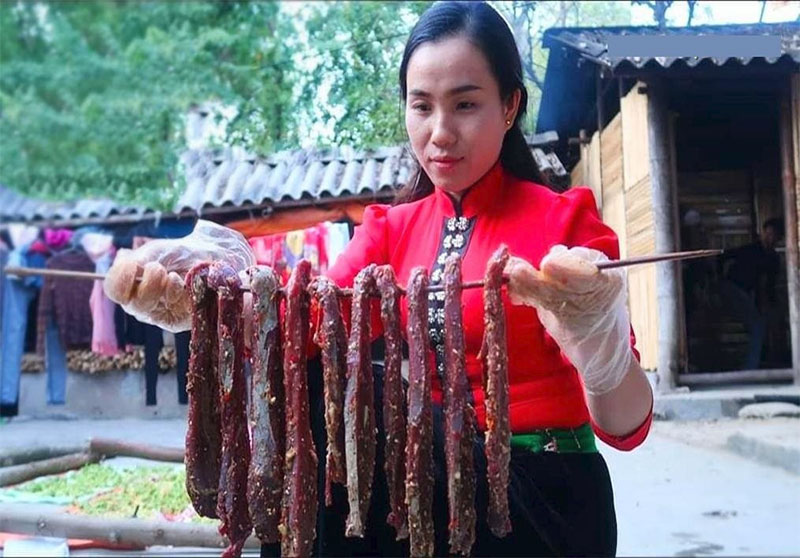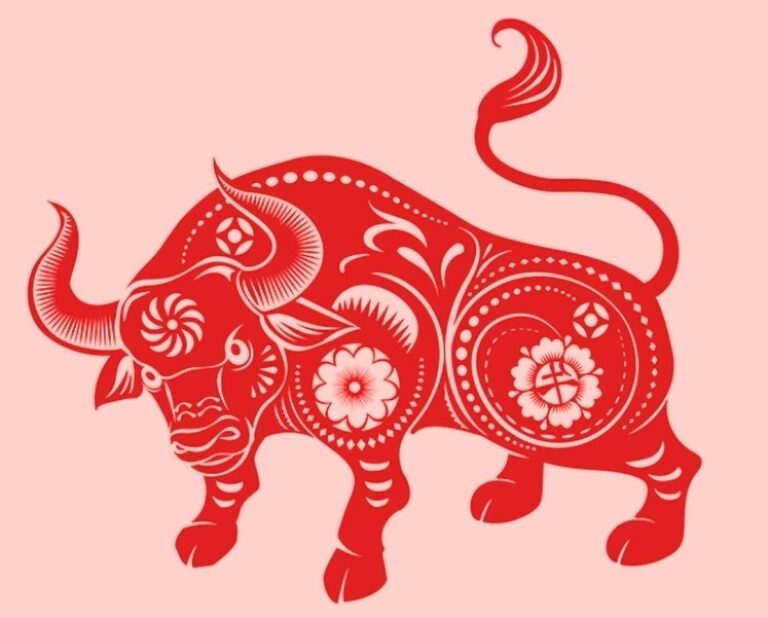
In many cultures, the image of the Buffalo is widespread, especially in Eastern culture. It is closely associated with people’s lives in Southeast and South Asia, especially in Vietnamese culture. Buffaloes are common in Africa and Asia but rare in Europe, the Middle East, and the Americas, so the image of buffaloes in art and culture mainly appears in Egypt, India, Northeast Asia, Southeast Asia, and South Asia.
Contents
1. Concept of Water Buffalo: The National Animal of Vietnam
The Buffalo is among the 12 zodiac animals, ranked second after the Rat and above ten other animals. Water buffalo is also the head of six livestock (including Buffalo, dog, horse, goat, chicken, and pig) and plays a vital role in wet rice agriculture.
The image of the Buffalo has been shown in all areas of the spiritual life of Vietnamese people for thousands of years. With the wet rice agricultural economy, farmers consider buffaloes close friends. The Buffalo is the symbolic image of a gentle, dynamic nature, symbolizing good health. Our ancestors long ago had a saying: “The buffalo is the beginning of the inheritance/ Con Trau la dau co nghiep” to express the critical position and role of the Buffalo in agricultural life. In production labor, farmers also draw folk experience from the image of the Buffalo. On New Year’s Eve, in the sacred space of heaven and earth, people go out to see whether the Buffalo is lying down or standing up. Turn your head out the door or inside to know if the business will be favorable that year.
The buffalo is the farmer’s companion and an indispensable laborer. The image of the buffalo permeates all walks of life. If farmers consider the buffalo a material asset of enormous value, people of status see the buffalo as a measure of wealth and prosperity. And over time, the buffalo has become a symbol of wet rice civilization. The buffalo is closely associated with the image of Vietnamese villages.
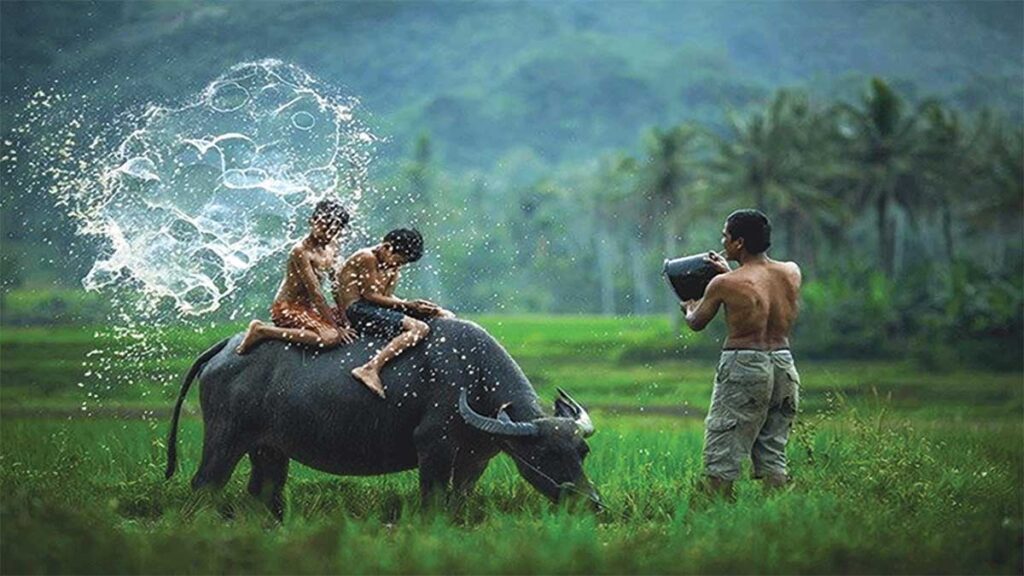
In Western culture, the Buffalo symbolizes strength and fortune. People consider horns made from buffalo horns symbols of the ancient postal industry. They blew horns to announce each time they delivered or received letters from traders. In the East, especially in Vietnam, the Buffalo symbolizes gentleness, diligence, and honesty, like the excellent nature of the Buffalo. Through thousands of years of change and development, the importance and meaning of the Buffalo remain unchanged.
In agricultural beliefs, the image of the Buffalo is also shown in many fields. According to cultural researchers, the buffalo horn motif in Vietnamese culture is also a symbol of the image of a crescent moon related to Vietnamese beliefs about agriculture and praying for rain. Buffalo skin covers the drum’s face. When praying for rain, people beat the drum to simulate thunder.
During the Ly-Tran Dynasty (11th – 14th centuries), in early spring, as a rule, the king himself personally held a ceremony to sacrifice to the God of Agriculture and plowed the fields of Tich Dien. The Tich Dien Festival brought a message as a reminder of the ancestors. To today’s generation, it is necessary to remember the contributions of our ancestors in clearing fields, growing rice, corn, and other crops, and focusing on agricultural production activities. The festival takes place at the beginning of the year with the hope of praying for peace, good weather, and good crops so that farmers can have a good year, helping their lives to be prosperous and happy.
In folk songs, buffaloes are mentioned a lot because buffaloes play an essential role in rural life. From similes about age to farming and love between men and women… all have the image of the Buffalo. In many folk songs and proverbs, the image of a buffalo also appears to teach people or convey life experiences.
The Buffalo from real life associated with agricultural people has entered the field of spiritual culture. Buffalo worship and buffalo sacrifices in folk festivals in many regions across the country also show the critical role of the Buffalo in the people’s traditional culture. With that role, the buffalo symbol has entered the Vietnamese zodiac calendar’s year, month, day, and hour. According to the Eastern can chi calendar, the cycle is closed with 12 numbers; the second number is the Ox, symbolized by the Buffalo. The hour of the Ox is calculated from 1 to 3 A.M, which is the quietest time. Everyone sleeps soundly, but the Buffalo is awake quietly, chewing its cud. The month of the Ox is December, the month when everyone happily celebrates Tet.
Because the Buffalo is so valued, some rural areas of our country celebrate the Buffalo New Year in Hoang Hoa, Nga Son (Thanh Hoa), and Vinh Linh (Quang Tri). A few days before Tet, people look for delicious grasses and choose straw exposed to the sun to reward buffaloes on Tet. The buffaloes are bathed, and the barns are carefully cleaned. On the morning of the first day of the Lunar New Year, each Buffalo has a talisman made of red paper attached to its forehead to “exorcise evil spirits” ward off the bad luck of the old year, and pray for the Buffalo to be safe and sound in the new year. Plow well. After worshiping the “god of the stable” the Buffalo can eat a feast and taste banh chung, banh gai, meat, fish, or sticky rice with sweet soup. And on “auspicious days,” people take the Buffalo for a walk around the Buffalo. .. enjoy spring, and at the same time plow for buffaloes for good luck.
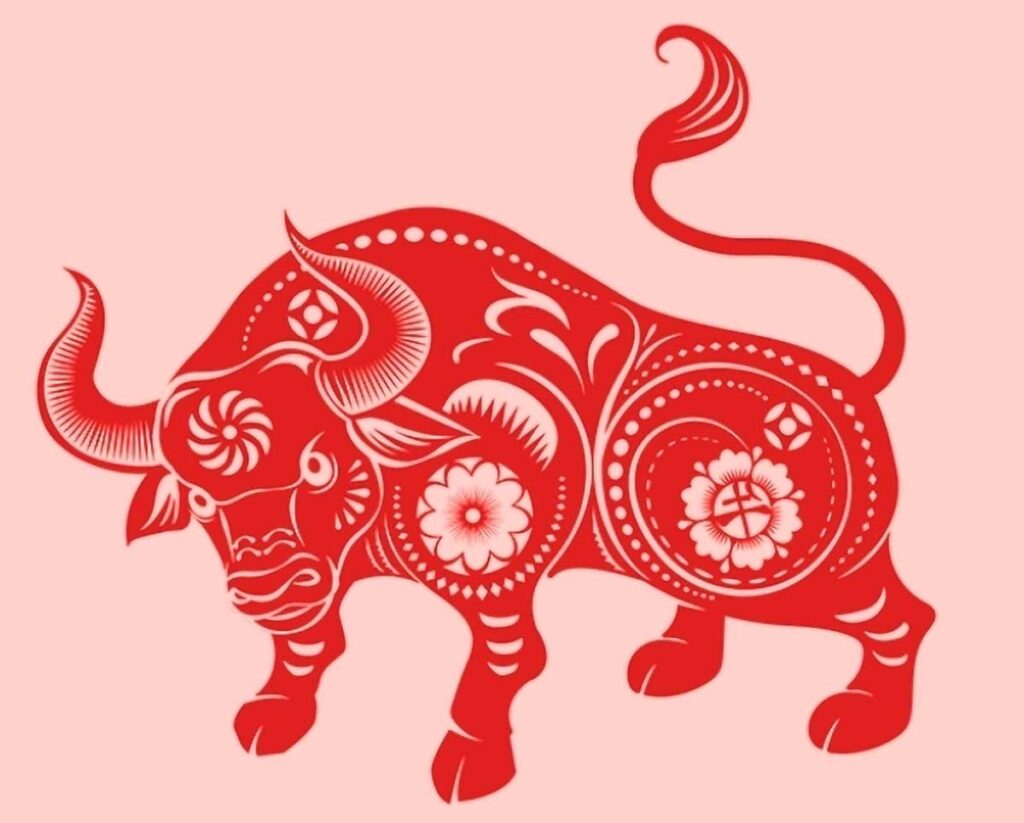
In addition, buffaloes are also associated with festivals such as buffalo fighting and buffalo stabbing… The Buffalo Fighting festival in Do Son (Hai Phong) is probably the most famous. No matter where you go or where you go/ On the ninth day of the eighth lunar month, you will return to the buffalo fight. The festival is a religious custom to thank the Sea God of the people here. The healthiest buffaloes will fight each other to find the winner. This Buffalo will be killed to worship the gods and pray for favorable weather and wind.
Buffalo horns are also a symbol of strength for many ethnic groups. Ancient people crafted buffalo horns into horns that were used to alert and stimulate soldiers during battle. Dao ethnic people in Luc Nam, Luc Ngan, and Son Dong (Bac Giang) also use the conch to call Ban Vuong in the ceremony of granting honor. The spring festival, also known as the spring spring festival, is an essential royal ceremony. It has been critical in Thang Long since the Ly Dynasty and maintained until the Nguyen Dynasty. The Spring Festival is held on the first day of spring every year. This is the ceremony of offering an earthen buffalo to expel winter’s cold air and welcome spring’s coming warmth. The ceremony to welcome the spring cow has two parts: to send off winter and to receive spring. In the Vietnamese Spring Festival, the Buffalo symbolizes spring and rebirth.
Vietnamese people’s spiritual life and productive labor have recognized Buffalo’s indispensable role from ancient times. The image of a diligent, industrious, and healthy Buffalo attached to the village bamboo has been one of the symbols of Vietnamese culture for thousands of years.
3. Interesting Facts about Water Buffalo – A Vietnamese National Animal
- Travel by buffalo cart: This initiative for the tourism industry is not in some strange, faraway country, but right here in… Vietnam. Realizing that tourists from all over the world have always visited their village in the style of “riding horses to see flowers” and not being able to keep up with the sound and beautiful things that are happening, Hanoi’s tourism industry has come up with a way to use buffalo carts to transport tourists. Guests visit Bat Trang pottery village. The Buffalo strolls, so the wheelchair rolls very slowly, allowing visitors to see the lively life of the famous pottery villagers slowly appearing before their eyes. Each hour sitting on a buffalo cart around the world of ceramics costs visitors only 45,000-50,000 VND!
- Unique buffalo bike: An old 88-year-old DH motorbike has been “enchanted” into a motorcycle shaped like a buffalo, the entire frame is made from… wood, and it is a work with a unique record. The story of a young man named Tran Van Dinh (born 1984) in Ho Chi Minh City. The buffalo cart is nearly 2 meters long, has a maximum speed of 120km/h, operates well, has a natural red color of glossy wood, only the engine and shock absorbers are metal, and has been ridden by the “inventor” all over the city… Ho Chi Minh was present in Vung Tau, Hue, Da Nang, Hanoi, etc. This youngest “record holder” in Vietnam had to spend over 30 million VND to buy materials to make the work “Buffalo Cart” not to mention the labor and travel costs of hunting for wooden spare parts and accessories as desired.
- 3-horned buffalo and 3-headed calf: Owning a unique collection of “beasts” in Vietnam and possibly the whole world, Mr. Vu Hai Nam in Loc Phat ward, Bao Loc town, Lam Dong province. In Mr. Nam’s collection, in addition to a 2-snouted pig, an 8-legged pig with two tails, a 6-legged cow, a 3-legged dog, a 2-headed snake, a 4-legged chicken, a pig with an elephant trunk… there is also a dead calf with two heads he had to buy for nearly 30 million VND and a live 3-horned calf. In China, there was also a 3-headed calf that went viral on the internet, attracting many curious people to see it.
- The most versatile buffalo athlete: Not a strange buffalo, but the “Golden Buffalo” of the 22nd SEA Games held in Vietnam. “Golden Buffalo” defeated rivals “Long Lan Quy Phung“, to win the right to transform into the “mascot” for the “22nd Southeast Asian Games – Vietnam 2003”. After that, our multi-purpose Buffalo immediately appeared in all competitions and brought a lot of luck to the host country.
- A young buffalo herder becomes a doctor: The famous Dr. Huynh Phuoc Duong in the US was born and raised in the countryside of Hoi An-Quang Nam. As a child, he was a buffalo herder. He stepped on a mine and lost both of his legs at the age of 11. He was then adopted by an American and brought to the United States in 1975. He was intelligent and diligent in his studies. He passed all levels quickly, entered the Department of Biotechnology, was always an excellent student, and received a doctorate in Biochemistry and Neuroscience, becoming a Professor at UCLA California. He returned to Vietnam to visit his old hometown and organized and enthusiastically participated in charity work in recent years.
- Giant wild Buffalo: Vietnam’s leading animal researchers were stunned when they witnessed a pair of giant horns discovered in an ancient forest in Thanh Hoa province. The pair of horns measures 2.18m in length if measured with a tape measure placed along the two curved horn branches. Stretching a tape measure between the two horn tips will be more than 1.8m. Experts believe this is a pair of horns of a giant wild buffalo, never seen before nor expected to exist in our country’s forests, and they will immediately promote the search, investigation, and research work. clarify the origin of this rare animal.
- The close friend to humans: For Vietnamese people, the Buffalo has been a close friend of farmers for thousands of years, and at the same time, the Buffalo is also a symbol of gentleness, hard work, and diligence in the concept of Vietnamese people.
Water buffalo cuisine in Vietnam – Specialties you wouldn’t expect
“Buffalo meat has the same nutritional value as beef. Buffalo meat has a higher iron content but less fat than beef. There is only 1.6 – 5.6% fat in buffalo meat compared to beef, which is 10 – 22%.“
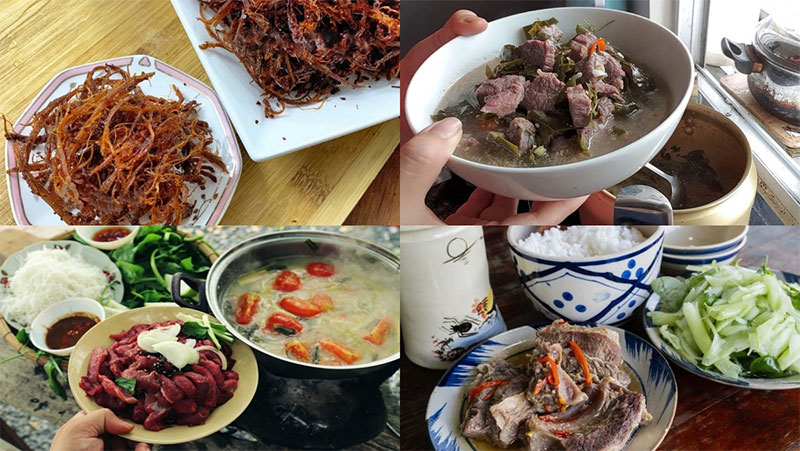
The buffalo is an effective means of service, closely associated with farmers in farming. Therefore, the number of buffaloes in Vietnamese villages is quite large, almost every house raises at least two, and many dwellings extend to dozens of buffaloes. The buffalo has devoted its whole life to living with farmers like that. Still, when the old buffalo dies, it also contributes to creating a folk culinary culture because of the diversity in cooking methods. This may surprise you, but it is entirely legal in Vietnam.
Buffalo meat can be used to make many delicious dishes. Each region has a different way of processing and preserving buffalo meat. The most popular is dried Buffalo meat. You can enjoy this delightful dish in the Northwest or Mekong Delta provinces.
